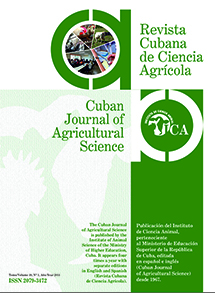Performance of the fertility and prolificacy at birth in the current populations of three rabbit breeds in Artemisa, Cuba
Contenido principal del artículo
Resumen
In order to study the performance of fertility and prolificacy traits at birth (total born and live born), a total of 14 659 records of mating and 8 296 kindlings of the current rabbit populations of California, Chinchilla and New Zealand breeds were used between 2014 and 2017, belonging to a genetic unit. A mixed generalized linear model was used, which considered the fixed effects of breed, month, year and the interactions breed x month and breed x year, in addition to the random effect of the reproducers in its different mating or kindlings. It was found that all sources of variation considered in the model influenced on the analyzed traits, except the interaction of breed per month of mating in fertility, so the studied traits vary depending on the interaction between breeds and environmental conditions (month and year). The highest fertility occurred in the mating of
April, March, May and July, and the lowest in January and August. California showed stability over time and remained the most fertile, when there were differences between breeds in the same year. There were divergences between breeds in the kindlings of February, June, September, October, November and December, with superiority of New Zealand, while Chinchilla had a worse performance for 70 % of those months. New Zealand remained the best in three years, with more than 5.6 total born and live born. This breed is ratified as the most promising for reproductive indicators that determine the rabbit productivity.
Key words: reproduction, breeds, rabbits, productivity.
April, March, May and July, and the lowest in January and August. California showed stability over time and remained the most fertile, when there were differences between breeds in the same year. There were divergences between breeds in the kindlings of February, June, September, October, November and December, with superiority of New Zealand, while Chinchilla had a worse performance for 70 % of those months. New Zealand remained the best in three years, with more than 5.6 total born and live born. This breed is ratified as the most promising for reproductive indicators that determine the rabbit productivity.
Key words: reproduction, breeds, rabbits, productivity.
Detalles del artículo
Cómo citar
García, D., García, Y., Ponce de león, R., & Ginorio, O. (2020). Performance of the fertility and prolificacy at birth in the current populations of three rabbit breeds in Artemisa, Cuba. Cuban Journal of Agricultural Science, 54(1). Recuperado a partir de https://mail.cjascience.com/index.php/CJAS/article/view/944
Sección
Genética
Aquellos autores/as que tengan publicaciones con esta revista, aceptan los términos siguientes:
- Los autores/as conservarán sus derechos de autor y garantizarán a la revista el derecho de primera publicación de su obra, el cuál estará simultáneamente sujeto a la Licencia Creative Commons Attribution-NonCommercial 4.0 International (CC BY-NC 4.0) que permite a terceros compartir la obra siempre que se indique su autor y su primera publicación esta revista. Bajo esta licencia el autor será libre de:
- Compartir — copiar y redistribuir el material en cualquier medio o formato
- Adaptar — remezclar, transformar y crear a partir del material
- El licenciador no puede revocar estas libertades mientras cumpla con los términos de la licencia
Bajo las siguientes condiciones:
- Reconocimiento — Debe reconocer adecuadamente la autoría, proporcionar un enlace a la licencia e indicar si se han realizado cambios. Puede hacerlo de cualquier manera razonable, pero no de una manera que sugiera que tiene el apoyo del licenciador o lo recibe por el uso que hace.
- NoComercial — No puede utilizar el material para una finalidad comercial.
- No hay restricciones adicionales — No puede aplicar términos legales o medidas tecnológicas que legalmente restrinjan realizar aquello que la licencia permite.
- Los autores/as podrán adoptar otros acuerdos de licencia no exclusiva de distribución de la versión de la obra publicada (p. ej.: depositarla en un archivo telemático institucional o publicarla en un volumen monográfico) siempre que se indique la publicación inicial en esta revista.
- Se permite y recomienda a los autores/as difundir su obra a través de Internet (p. ej.: en archivos telemáticos institucionales o en su página web) antes y durante el proceso de envío, lo cual puede producir intercambios interesantes y aumentar las citas de la obra publicada. (Véase El efecto del acceso abierto).
